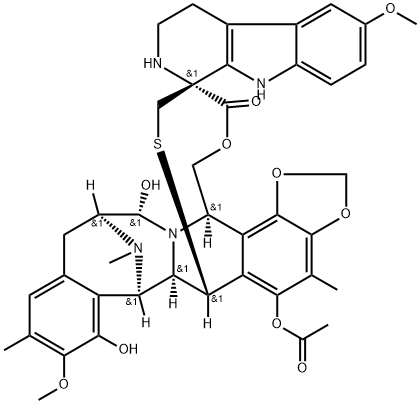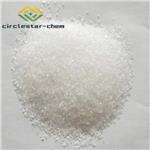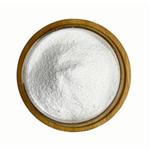Lurbinectedin is a synthetic tetrahydropyrrolo [4, 3, 2-de]quinolin-8(1H)-one alkaloid analogue with potential antineoplastic activity. Lurbinectedin covalently binds to residues lying in the minor groove of DNA, which may result in delayed progression through S phase, cell cycle arrest in the G2/M phase and cell death. Lurbinectedin was approved for medical use in the United States in June 2020.
Lurbinectedin is being developed for the treatment of various cancers. It has been granted approval for treatment of metastatic small cell lung cancer.
Lurbinectedin is indicated for the treatment of adult patients with metastatic small cell lung cancer (SCLC) with disease progression on or after platinum-based chemotherapy.
Lurbinectedin (PM01183, PM-1183, LY-01017, Tryptamicidin, Zepsyre, ZEPZELCA), a DNA minor groove covalent binder with potent in vitro and in vivo anti-tumour activity. Lurbinectedin inhibits RMG1 and RMG2 cell growth with IC50 of 1.25 nM and 1.16 nM, respectively.
Lurbinectedin is a next-generation DNA minor groove binder that exerts potent antitumor activity in a low nanomolar range. Furthermore, it inhibits RNA-polymerase-II activity and promotes its specific degradation by the ubiquitin/proteasome machinery. In several human cancer cell lines, lurbinectedin blocks the transcription process through binding to CG-rich sequences near the promoters of protein-coding genes. This drug triggers both the degradation of phosphorylated RNA polymerase II (Pol II) on the DNA template and the generation of SSBs and DSBs that drive tumor cells to apoptosis. By attenuating the activity of the nucleotide excision repair (NER) mechanism, lurbinectedin was able to overcome cisplatin resistance in NER hyperactive cell lines. Lurbinectedin was also shown to inactivate Ewing Sarcoma Oncoprotein (EWS-FLI1) by nuclear redistribution leading to promotor inactivity and decreased mRNA and protein levels[1-2].
The most common side effects include leukopenia, lymphopenia, fatigue, anemia, neutropenia, increased creatinine, increased alanine aminotransferase, increased glucose, thrombocytopenia, nausea, decreased appetite, musculoskeletal pain, decreased albumin, constipation, dyspnea, decreased sodium, increased aspartate aminotransferase, vomiting, cough, decreased magnesium and diarrhea.
Lurbinectedin exhibits significant antitumor activity toward chemosensitive and chemoresistant CCC cells in vitro. Lurbinectedin plus SN-38 combination has strong synergistic effects on both the cisplatin-resistant and paclitaxel-resistant CCC cell lines.
An examination of mouse CCC cell xenografts reveals that lurbinectedin significantly inhibits tumor growth. Lurbinectedin plus SN-38 combination results in a significant synergistic effect. Everolimus significantly enhances the antitumor activity of lurbinectedin-based chemotherapies.
Lurbinectedin is an Alkylating Drug. The mechanism of action of lurbinectedin is as an Alkylating Activity.
[1] Kauffmann-Guerrero D, et al. Orphan Drugs in Development for the Treatment of Small-Cell Lung Cancer: Emerging Data on Lurbinectedin. Lung Cancer: Targets and Therapy, 2020; 11: 27–31.
[2] Gadducci A, et al. Trabectedin and lurbinectedin: Mechanisms of action, clinical impact, and future perspectives in uterine and soft tissue sarcoma, ovarian carcinoma, and endometrial carcinoma. Frontiers in Oncology, 2022; 12: 914342.



